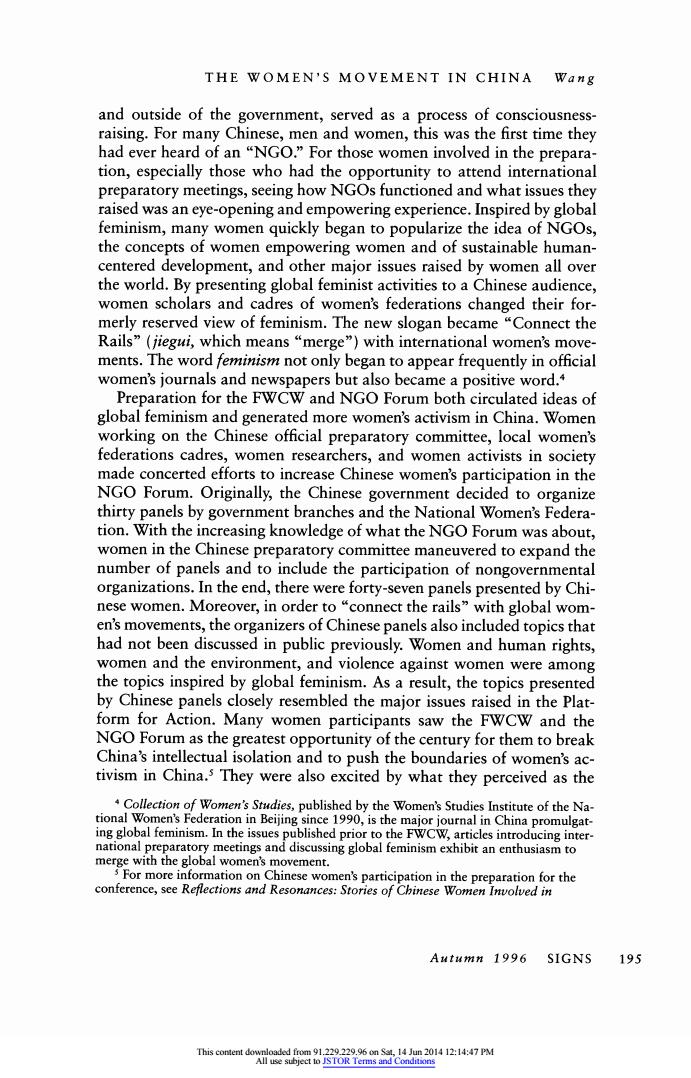正在加载图片...

THE WOMEN'S MOVEMENT IN CHINA Wang and outside of the government,served as a process of consciousness- raising.For many Chinese,men and women,this was the first time they had ever heard of an "NGO."For those women involved in the prepara- tion,especially those who had the opportunity to attend international preparatory meetings,seeing how NGOs functioned and what issues they raised was an eye-opening and empowering experience.Inspired by global feminism,many women quickly began to popularize the idea of NGOs, the concepts of women empowering women and of sustainable human- centered development,and other major issues raised by women all over the world.By presenting global feminist activities to a Chinese audience, women scholars and cadres of women's federations changed their for- merly reserved view of feminism.The new slogan became "Connect the Rails"(jiegui,which means "merge")with international women's move- ments.The word feminism not only began to appear frequently in official women's journals and newspapers but also became a positive word. Preparation for the FWCW and NGO Forum both circulated ideas of global feminism and generated more women's activism in China.Women working on the Chinese official preparatory committee,local women's federations cadres,women researchers,and women activists in society made concerted efforts to increase Chinese women's participation in the NGO Forum.Originally,the Chinese government decided to organize thirty panels by government branches and the National Women's Federa- tion.With the increasing knowledge of what the NGO Forum was about, women in the Chinese preparatory committee maneuvered to expand the number of panels and to include the participation of nongovernmental organizations.In the end,there were forty-seven panels presented by Chi- nese women.Moreover,in order to "connect the rails"with global wom- en's movements,the organizers of Chinese panels also included topics that had not been discussed in public previously.Women and human rights, women and the environment,and violence against women were among the topics inspired by global feminism.As a result,the topics presented by Chinese panels closely resembled the major issues raised in the Plat- form for Action.Many women participants saw the FWCW and the NGO Forum as the greatest opportunity of the century for them to break China's intellectual isolation and to push the boundaries of women's ac- tivism in China.s They were also excited by what they perceived as the Collection of Women's Studies,published by the Women's Studies Institute of the Na- tional Women's Federation in Beijing since 1990,is the major journal in China promulgat- ing global feminism.In the issues published prior to the FWCW,articles introducing inter- national preparatory meetings and discussing global feminism exhibit an enthusiasm to merge with the global women's movement. s For more information on Chinese women's participation in the preparation for the conference,see Reflections and Resonances:Stories of Chinese Women Involved in Autumn 1996 SIGNS 195 This content downloaded from 91.229.229.96 on Sat,14 Jun 2014 12:14:47 PM All use subject to JSTOR Terms and ConditionsTHE WOMEN'S MOVEMENT IN CHINA Wang and outside of the government, served as a process of consciousnessraising. For many Chinese, men and women, this was the first time they had ever heard of an "NGO." For those women involved in the preparation, especially those who had the opportunity to attend international preparatory meetings, seeing how NGOs functioned and what issues they raised was an eye-opening and empowering experience. Inspired by global feminism, many women quickly began to popularize the idea of NGOs, the concepts of women empowering women and of sustainable humancentered development, and other major issues raised by women all over the world. By presenting global feminist activities to a Chinese audience, women scholars and cadres of women's federations changed their formerly reserved view of feminism. The new slogan became "Connect the Rails" (jiegui, which means "merge") with international women's movements. The word feminism not only began to appear frequently in official women's journals and newspapers but also became a positive word.4 Preparation for the FWCW and NGO Forum both circulated ideas of global feminism and generated more women's activism in China. Women working on the Chinese official preparatory committee, local women's federations cadres, women researchers, and women activists in society made concerted efforts to increase Chinese women's participation in the NGO Forum. Originally, the Chinese government decided to organize thirty panels by government branches and the National Women's Federation. With the increasing knowledge of what the NGO Forum was about, women in the Chinese preparatory committee maneuvered to expand the number of panels and to include the participation of nongovernmental organizations. In the end, there were forty-seven panels presented by Chinese women. Moreover, in order to "connect the rails" with global women's movements, the organizers of Chinese panels also included topics that had not been discussed in public previously. Women and human rights, women and the environment, and violence against women were among the topics inspired by global feminism. As a result, the topics presented by Chinese panels closely resembled the major issues raised in the Platform for Action. Many women participants saw the FWCW and the NGO Forum as the greatest opportunity of the century for them to break China's intellectual isolation and to push the boundaries of women's activism in China.5 They were also excited by what they perceived as the 4 Collection of Women's Studies, published by the Women's Studies Institute of the National Women's Federation in Beijing since 1990, is the major journal in China promulgating global feminism. Inthe issues published prior to the FWCW, articles introducing international preparatory meetings and discussing global feminism exhibit an enthusiasm to merge with the global women's movement. 5 For more information Chinese women's participation in the preparation for the conference, see Reflections and Resonances: Stories of Chinese Women Involved in Autumn 1996 SIGNS 195 This content downloaded from 91.229.229.96 on Sat, 14 Jun 2014 12:14:47 PM All use subject to JSTOR Terms and Conditions